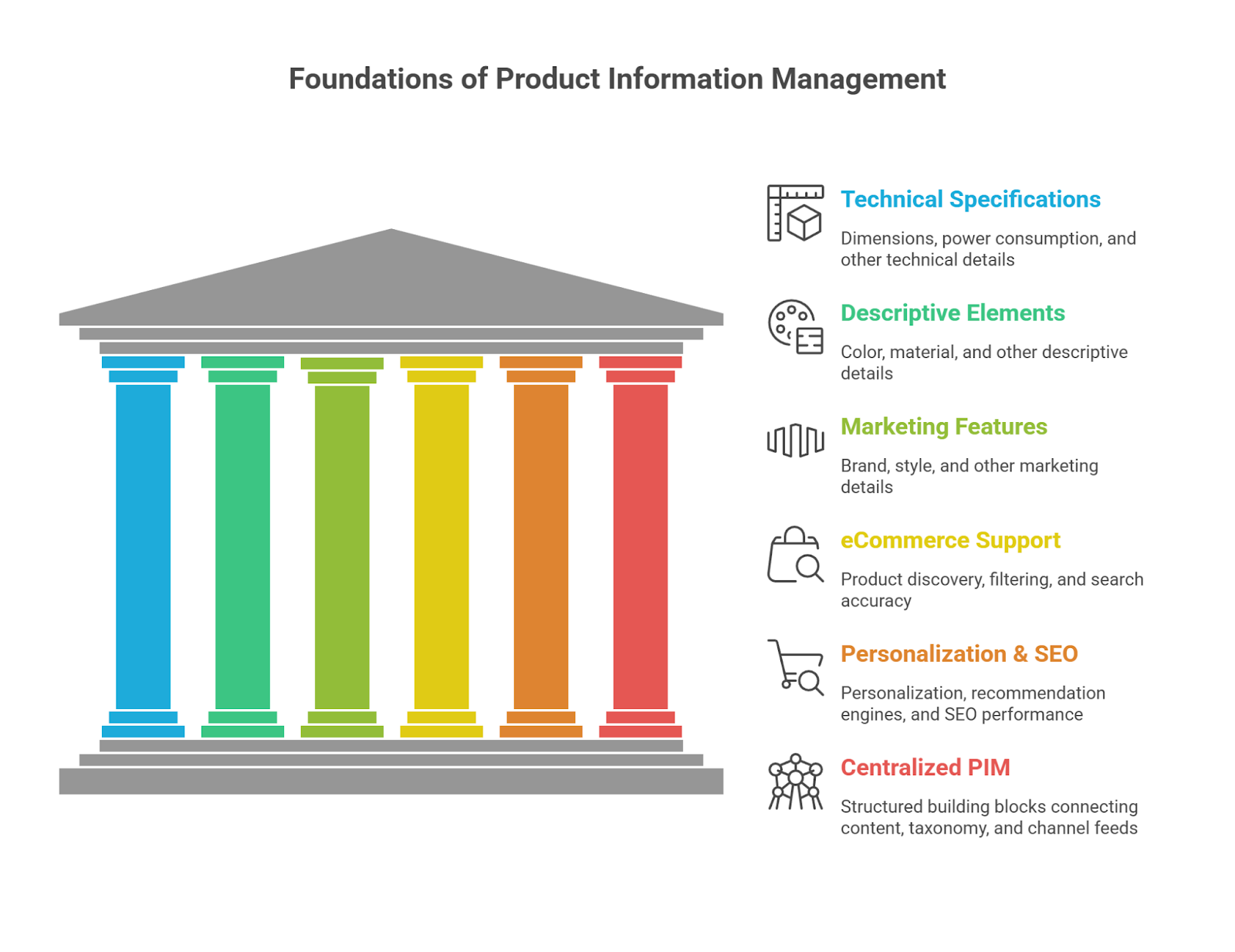Product Attributes Explained: Build Data That Sells

Product Attributes Explained: Build Data That Sells
Every product tells a story, and its attributes are the language that brings it to life.
Product attributes define how customers discover, compare, and decide what to buy. They shape how search engines index your catalog and how your team maintains product data across channels.
For businesses managing thousands of SKUs, attributes are the foundation for scalable, consistent, and high-performing product information management (PIM).
This guide unpacks how to structure, manage, and optimize product attributes that not only inform but also sell. It provides a hands-on roadmap for teams aiming to build an efficient attribute model powered by a PIM like Ergonode.
What Product Attributes Mean and Why They Matter

Product attributes are the defining details that describe and differentiate items in your catalog. They can be technical specifications like dimensions or power consumption, descriptive elements such as color and material, or marketing features such as brand and style.
Strong attribute data supports product discovery on eCommerce platforms, improves filtering and search accuracy, and ensures a consistent experience across all channels. Attributes also fuel personalization, recommendation engines, and SEO performance.
In a centralized PIM system, attributes act as structured building blocks. They connect content, taxonomy, and channel feeds, giving teams a unified “single source of truth.”
This reduces manual errors, speeds up launches, and enhances catalog integrity.
Types of Product Attributes and When to Use Each
Understanding attribute types helps you decide which details truly influence purchase decisions.
- Technical Attributes define measurable features like weight, voltage, or size define measurable features like weight, voltage, or size. They are crucial for accurate filtering and comparison on category pages.
- Descriptive Attributes convey visual or tactile characteristics, such as fabric type, color, or finish. These appeal to consumer emotion and design preference.
- Marketing Attributes highlight selling points, including brand, product tagline, or unique value proposition. These improve engagement and drive conversions.
- Logistics Attributes focus on the operational side, involving packaging size, shipping class, or lead time. These ensure fulfillment accuracy and optimize inventory management.
- Dynamic or Customizable Attributes evolve based on product configurations or personalization, like “engraving text” or “subscription term.”
Retailers may emphasize color and size variations, while B2B companies rely on technical and compliance data. The balance of these attributes directly influences product visibility and conversion rate.
How to Define a Product Attribute Taxonomy That Scales
A clear taxonomy organizes product attributes into logical hierarchies. This allows teams to maintain data consistency across expanding catalogs.
Start by grouping products into families or types. Identify shared attributes (e.g., “brand,” “SKU”) and type-specific ones (e.g., “screen size” for TVs). From there, create attribute templates that define required and optional fields per product family.
Consistency is key. Use standardized naming conventions such as “Color Name” instead of “Colour” or “Shade.” Define value lists (“Red,” “Blue,” “Green”) to prevent duplication.
A scalable taxonomy also maps attributes to channels. For instance, linking “Material” to both website filters and marketplace export fields. Avoid attribute sprawl by auditing inactive or redundant attributes regularly.
The result is a taxonomy that supports flexibility without sacrificing order.
That’s essential for omnichannel growth.
Attribute Data Model and Schema Best Practices
A well-structured attribute schema defines how attributes interact with each other and with the broader product model.
Each attribute should have:
- Data Type (text, number, boolean, date, or list)
- Validation Rules (minimum/maximum values, allowed formats)
- Relationships (dependencies, parent/child connections)
- Metadata (language, units, or visibility rules)
For example, “Size” may be a numeric attribute linked with “Unit of Measurement,” while “Color” is a predefined list validated against standardized values.
Standard identifiers such as SKU, GTIN, or EAN connect internal data with external systems, simplifying exports and integration. In a PIM like Ergonode, schemas can be defined through the API, ensuring data consistency across every connected channel.
Managing Product Attribute Data at Scale With PIM
As catalogs expand, spreadsheets and manual tracking quickly become unsustainable. A PIM system offers structure, automation, and collaboration for managing product attributes.
Ergonode’s API-first architecture enables real-time synchronization with eCommerce platforms, marketplaces, and ERPs.
- Teams can import bulk data, enrich attributes, and validate accuracy before publishing.
- Workflow automation reduces repetitive tasks such as flagging missing attributes or enforcing naming rules.
- Governance features define ownership for each product family, ensuring accountability and consistency.
- Meanwhile, enrichment tools streamline translation and localization, allowing global brands to maintain uniform quality across languages and regions.
The result is cleaner, faster, and more scalable product attribute management that supports both operational efficiency and superior customer experience.
Attribute Governance and Quality Checklist
High-quality attribute data requires governance. Use this checklist to maintain consistency and reliability across your catalog.
By maintaining governance discipline, teams can ensure that attribute data remains complete, compliant, and conversion-ready.
SEO and Conversion Optimization for Product Attributes
Attributes play a direct role in search engine optimization and conversion performance.
Search engines read structured data from attributes to understand products. Implement schema.org Product markup that maps key attributes such as “brand,” “color,” “material,” and “dimensions.”
This enhances visibility through rich snippets in Google Search.
Attributes also improve on-site SEO by powering faceted navigation and internal linking
For example, each color or size variation can generate indexable, optimized category pages.
Use clear, keyword-relevant attribute names that match how users search: “wireless headphones” rather than “headphones model 2X.” Keep attribute values concise and standardized to avoid confusion and duplicate content.
For multilingual catalogs, ensure localized attribute names and values align with the user’s language for both UX and SEO benefits.
Practical Templates and Examples
Apparel Attribute Template
Electronics Attribute Template
These templates serve as starting points for standardized product attribute enrichment and import/export workflows within Ergonode.
Implementation Roadmap and Quick Wins
Teams can implement robust attribute management in five focused steps:
- Audit Existing Data: Identify incomplete or inconsistent attributes.
- Prioritize Core SKUs: Start with high-volume or high-margin products.
- Build Attribute Taxonomy and Templates: Establish shared definitions.
- Pilot in PIM: Test imports, workflows, and automation rules.
- Scale to All Channels: Synchronize attributes across marketplaces, CMS, and ERP.
Measurable success indicators include improved catalog completeness, reduced product return rates, and higher search visibility. Quick wins such as cleaning top 10 missing attributes or standardizing color names can yield noticeable conversion uplifts.
Transform Your Product Attributes Into a Sales Engine
Product attributes are the foundation of how customers and systems understand your products.
Structured, validated, and optimized attributes elevate search rankings, enhance customer confidence, and streamline omnichannel operations.
Use the provided templates and governance checklist to start improving your data today. Then, take it further by implementing these best practices through Ergonode’s modern, cloud-native PIM.
Better product data builds stronger brands. And ultimately, data that sells.






